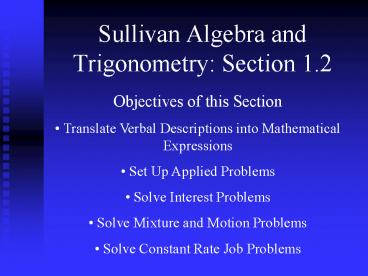Sullivan Algebra and Trigonometry: Section 1.2 - PowerPoint PPT Presentation
1 / 10
Title:
Sullivan Algebra and Trigonometry: Section 1.2
Description:
Sullivan Algebra and Trigonometry: Section 1.2 Objectives of this Section Translate Verbal Descriptions into Mathematical Expressions Set Up Applied Problems – PowerPoint PPT presentation
Number of Views:99
Avg rating:3.0/5.0
Title: Sullivan Algebra and Trigonometry: Section 1.2
1
Sullivan Algebra and Trigonometry Section 1.2
- Objectives of this Section
- Translate Verbal Descriptions into Mathematical
Expressions - Set Up Applied Problems
- Solve Interest Problems
- Solve Mixture and Motion Problems
- Solve Constant Rate Job Problems
2
Translating English into Math Examples
3
Steps for Setting Up Applied Problems
Step 1 Read the problem carefully, perhaps two
or three times. Identify what you are looking
for.
Step 2 Assign a letter (variable) to represent
what you are looking for. Express any remaining
unknown quantities in terms of that variable.
Step 3 Make a list of known facts and translate
them into mathematical expressions. These may
take the form of an equation or later, an
inequality.
Step 4 Solve the equation for the variable and
answer the question using a sentence.
Step 5 Check your answer with the facts of the
problem.
4
Example Yolanda, Mary, and Sophie won 200,000
playing the lottery. Based on how much each
contributed to buy the ticket, Mary gets four
fifths of what Yolanda gets, while Sophie gets
three fourth of what Mary gets. How much does
each receive?
5
(No Transcript)
6
Example The suggested list price of a new car
is 16,000. The dealer cost is 80 of list. How
much will you pay if the dealer is willing to
accept 2000 over the cost for the car?
x cost to you y cost to the dealer
7
Example The purity of gold is measured in
karats, with pure gold being 24 karats. Other
purities of gold are expressed as proportional
parts of pure gold. Thus, 18 karat gold is
18/24, or 75 pure gold. How much 12 karat gold
should be mixed with 18 karat gold to obtain 50
grams of 14 karat gold?
8
(No Transcript)
9
Example Jeff can mow his lawn in 3 hours.
Melissa can mow the same lawn in 2 hours.
Working together, how long will the job take,
assuming that there is no gain or loss of
efficiency working together.
t hours needed to complete the job together
10
Part done together in 1 hour































